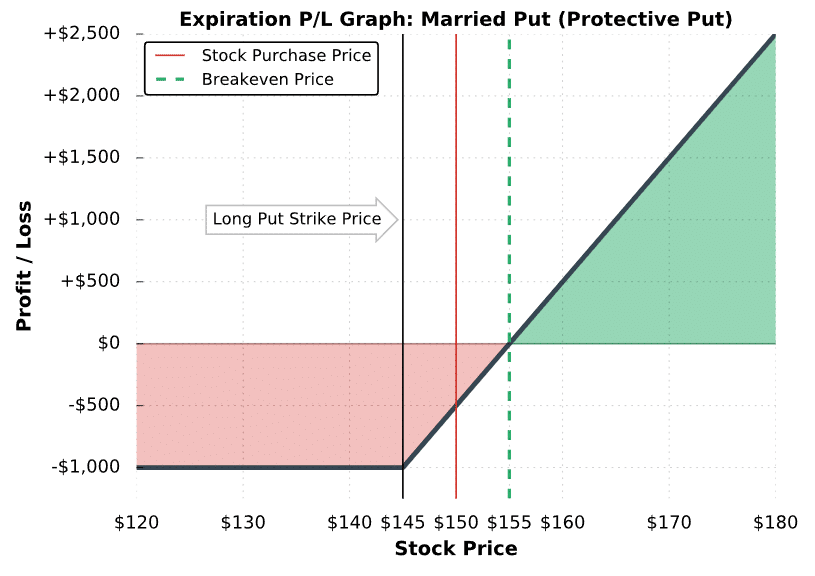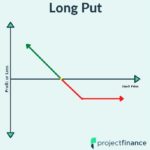Last updated on February 10th, 2022 , 02:02 pm
The protective put options strategy (also known as a “married put”) consists of buying a put option against 100 shares of long stock.
As the name suggests, a protective put is a defensive strategy that reduces the risk of owning shares of stock.
When a put is purchased against 100 shares of stock, the risk of those shares is eliminated below the strike price of the put option. The risk reduction comes at the cost of increasing the breakeven price on the shares, as the shares must increase by the cost of the put option for the strategy to break even at the expiration date of the put option.
TAKEAWAYS
- The protective put consists of 1.) purchasing 100 shares of stock and 2.) purchasing one put option.
- Protective puts allow investors to sell their long stock at the puts strike price.
- Protective puts are great for bullish yet jittery markets.
- Max loss on the protective put is the current stock price minus the strike price
- Max profit on a protective put is uncapped.
Protective Put Options Strategy Characteristics
Let’s go over the strategy’s general characteristics:
○Max Profit Potential: Unlimited
○Max Loss Potential: [(Stock Purchase Price – Put Strike Price) + Debit Paid for Put] x 100
○Expiration Breakeven: Stock Purchase Price + Debit Paid for Put
○Estimated Probability of Profit:
Less than 50% because the price paid for the put increases the effective purchase price of the shares.
To demonstrate these characteristics in action, let’s take a look at a basic example.
Protective Put: Profits/Losses at Expiration
In the following example, we’ll construct a protective put from the following option chain:
In this case, we’ll buy the 145 put for $5.00. Let’s also assume 100 shares of stock were purchased for $150 per share.
Initial Stock Purchase Price: $150
Long Put Strike Used: $145 Put
Debit Paid for Put: $5.00
Breakeven Price: $150 share purchase price + $5.00 put price = $155
Maximum Profit Potential: Unlimited
Maximum Loss Potential: $1,000 [(150 Stock Purchase Price – 145 Put Strike) + $5.00 Paid for Put] x $100
The following visual describes the position’s potential profits and losses at expiration:
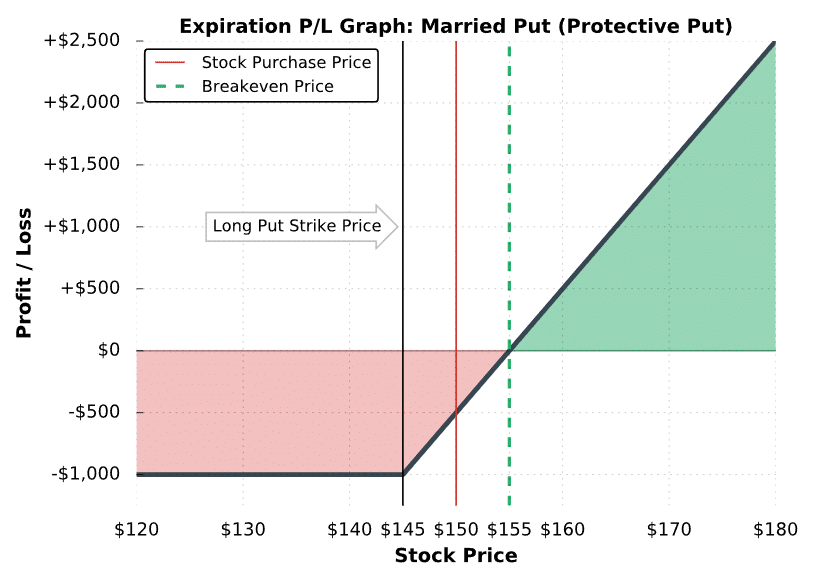
Protective Put Trade Results
As we can see here, the position will be unprofitable at any stock price below $155. Since the shares were purchased at $150, this means the stock price must rise $5 before any profits occur at expiration. Because of this, the probability of making money on this trade is less than 50%, in theory. However, the risk of the shares has been eliminated below $145, which is the strike price of the protective put.
Below explains the performance of this position based on various scenarios at expiration:
Protective Put at Different Expirations
○Stock Price Below the Long Put Strike ($145)
The value of the 145 put offsets the losses on the long shares, capping the maximum loss potential to $1,000. For example, at $130, the 145 put will be worth $15 at expiration, resulting in a $1,000 profit on the long put. The long shares will have a loss of $2,000 since they were purchased at $150. Consequently, the net loss is $1,000.
○Stock Price Between the Long Put Strike ($145) and the Stock Purchase Price ($150)
The long 145 put expires worthless ($500 loss), and the long shares are unprofitable. The loss is therefore between -$500 and -$1,000.
○Stock Price Between the Share Purchase Price ($150) and the Breakeven Price ($155)
The long shares are profitable, but not more than the $5 premium that was paid for the 145 put. Overall, the position is not profitable.
○Stock Price Above the Breakeven Price ($155)
The profit on the long shares exceeds the $5 in premium that was paid for the 145 put. As a result, the position is profitable. The exact profits are equal to: (Stock Price – $155) x 100.
Great job! You’ve learned the general characteristics of the protective put strategy. Now, let’s go through some visual trade examples to understand the strategy’s performance through time.
Married Put (Protective Put) Trade Examples
In the following examples, note that we don’t specify the underlying because the same concepts apply to protective puts on any stock. Additionally, each example demonstrates the performance of a single married put position. When trading more contracts, the profits and losses in each case are magnified by the number of protective puts traded.
Let’s do it!
Profitable Protective Put - Trade Example #1
The first example we’ll look at is a scenario where a hypothetical trader makes a small profit after entering a protective put.
Share Purchase Price: $77.21
Put Strike and Expiration: Long 77.5 put expiring in 74 days
Premium Paid for Put: $4.95
Breakeven Price (Effective Share Cost):
$77.21 share purchase price + $4.95 put purchase price = $82.16
Maximum Profit Potential:
Unlimited
Maximum Loss Potential:
[($77.21 share purchase price – $77.5 put strike) + $4.95 premium paid for put] x 100 = $466
Let’s see what happens!
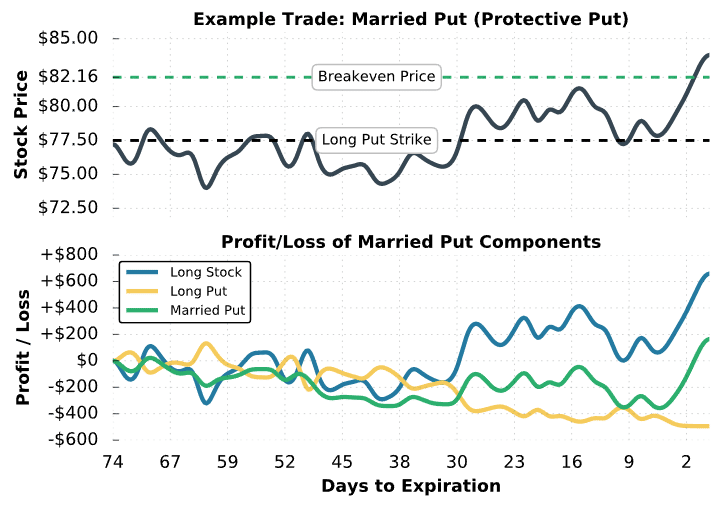
Protective Put #1 Trade Results
In the top half of the chart, we can see the stock price over time, as well as the long put strike and the position’s breakeven price. In the bottom half of the chart, we can see the performance of a married put’s components (the green line represents the combined performance of the components).
The above example demonstrates how purchasing a put against shares of stock reduces the overal profits on the long stock position. In this case, the married put position performs $495 worse than the long stock position, which is the cost of the 77.5 put.
Reducing Risk With a Protective Put - Trade Example #2
In the following example, we’ll investigate a situation where the stock price collapses after a hypothetical trader enters into a married put position. Here’s the setup:
Share Purchase Price: $254.53
Put Strike and Expiration: Long 245 put expiring in 37 days
Premium Paid for Put: $14.15
Breakeven Price (Effective Share Cost):
$254.53 share purchase price + $14.15 put purchase price = $268.68
Maximum Profit Potential:
Unlimited
Maximum Loss Potential:
[($254.53 share purchase price – $245 put strike) + $14.15 premium paid for put] x 100 = $2,368
Let’s take a look at the trade performance:
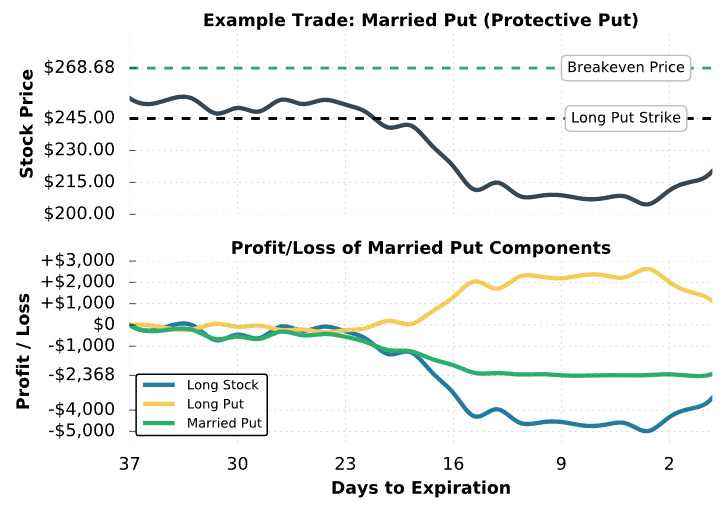
Protective Put #2 Trade Results
In this example, we can see that the stock price collapses from $254.53 to nearly $200 in a short period of time. Consequently, the long stock position suffers significant losses. However, the protective put position outperforms because the long put gains value as the stock price decreases. Additionally, we can see that the position’s losses are capped at $2,368, which is the maximum loss potential of this particular trade.
At expiration, the long put would expire to -100 shares of stock. Since the protective put trader already owns 100 shares of stock, the positions would offset and the trader would be left with no shares.
Final Word
Congratulations! You now know how selling the protective put options strategy works! Be sure to read the recap of main points below!
- Combining stock with a long put is known both as a “protective put” and a “married put”.
- Time decay works against the long put.
- A rise in implied volatility increases the value of all options.
- Because of the long stock, the upside in this strategy is capped, but this is lessened by the amount of premium paid for the put .
Next Lesson

